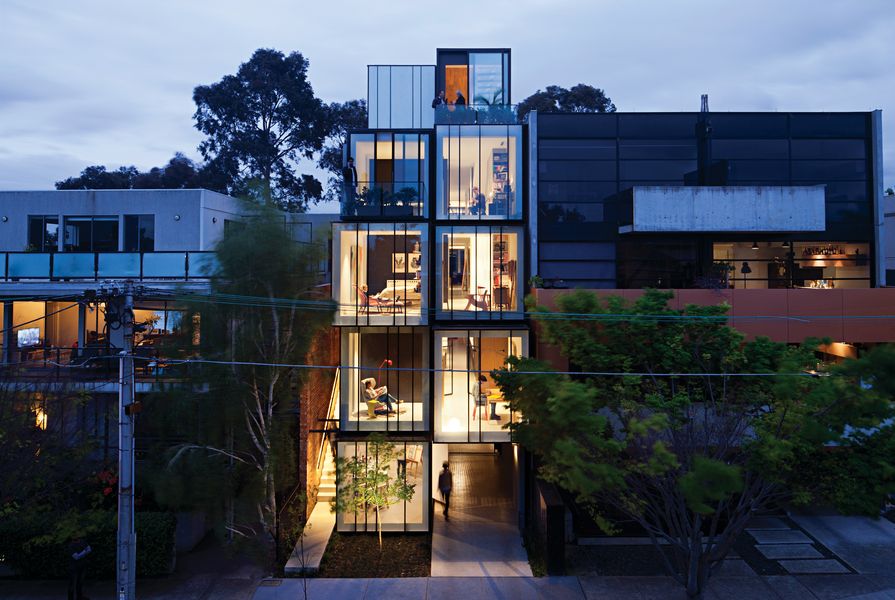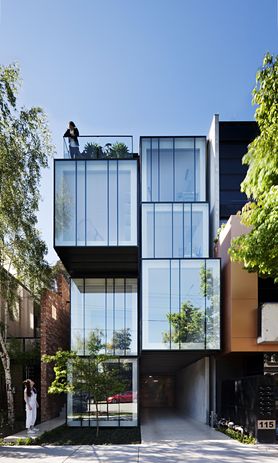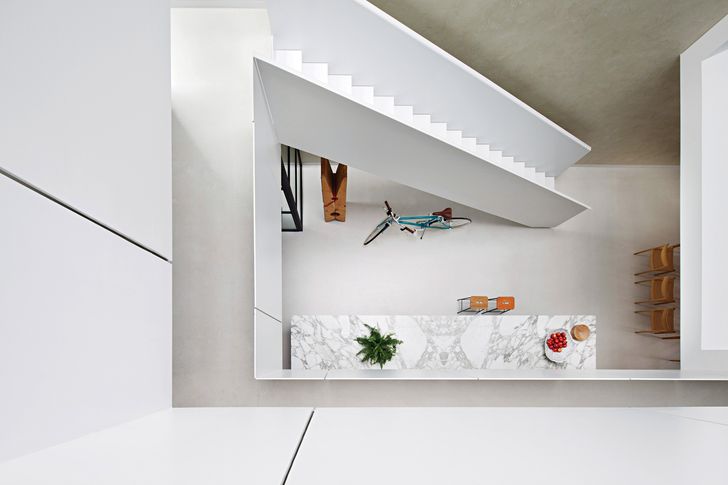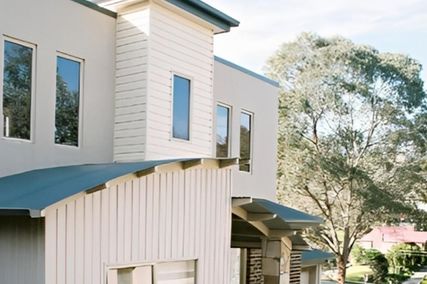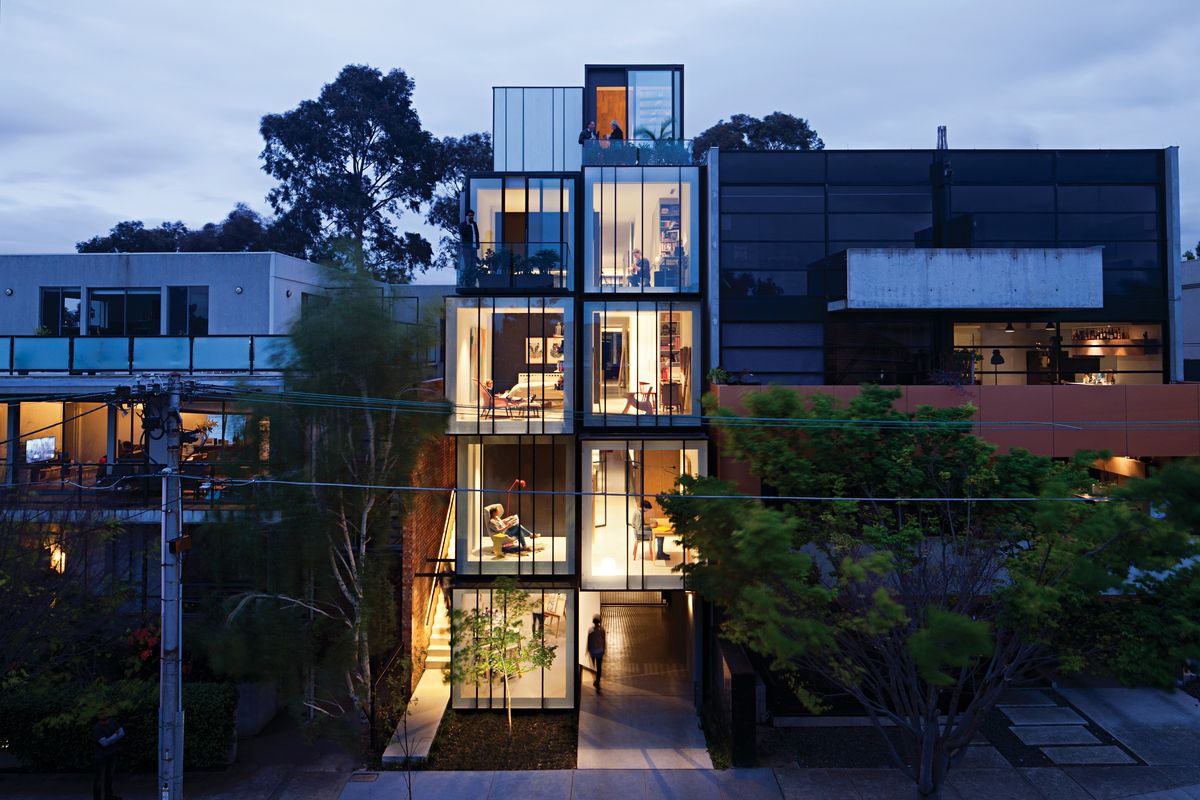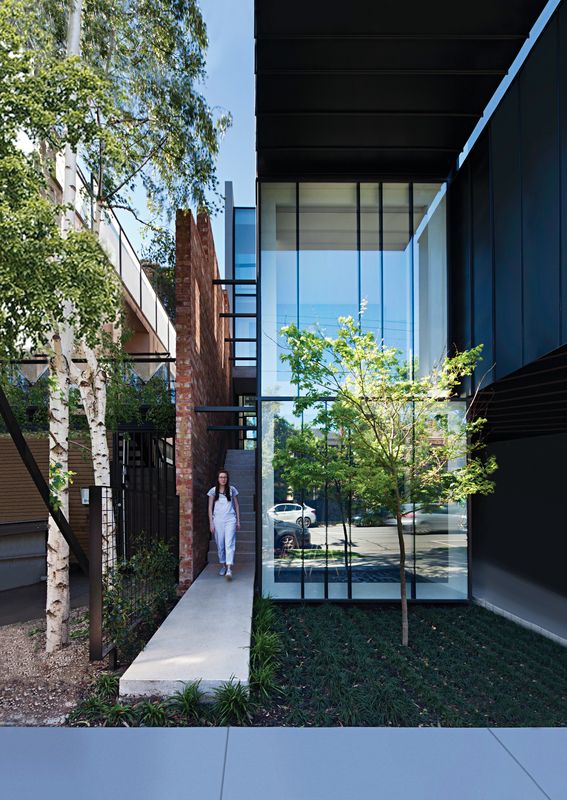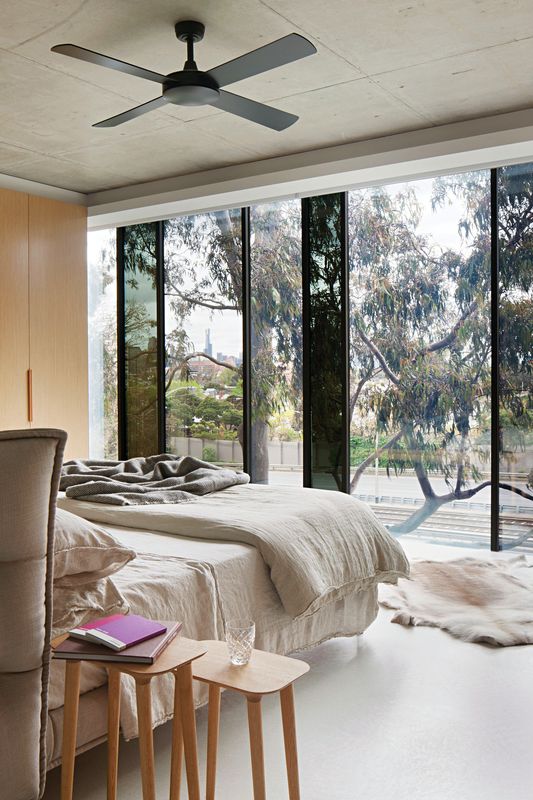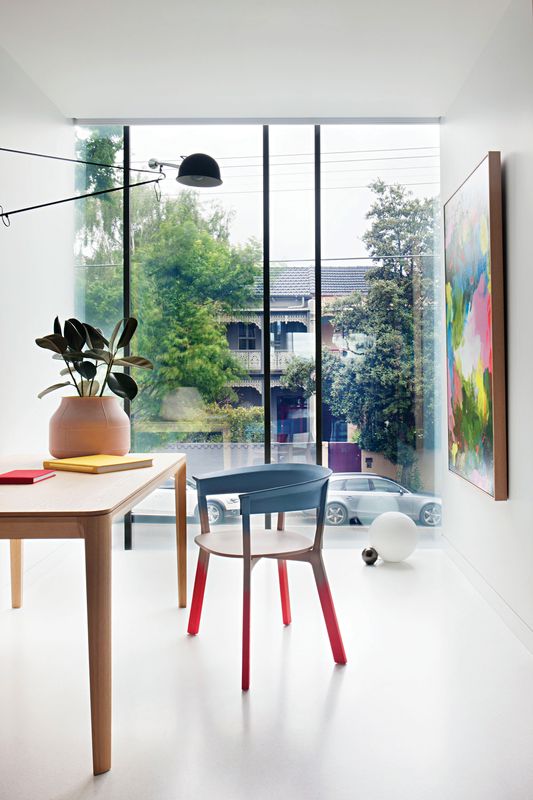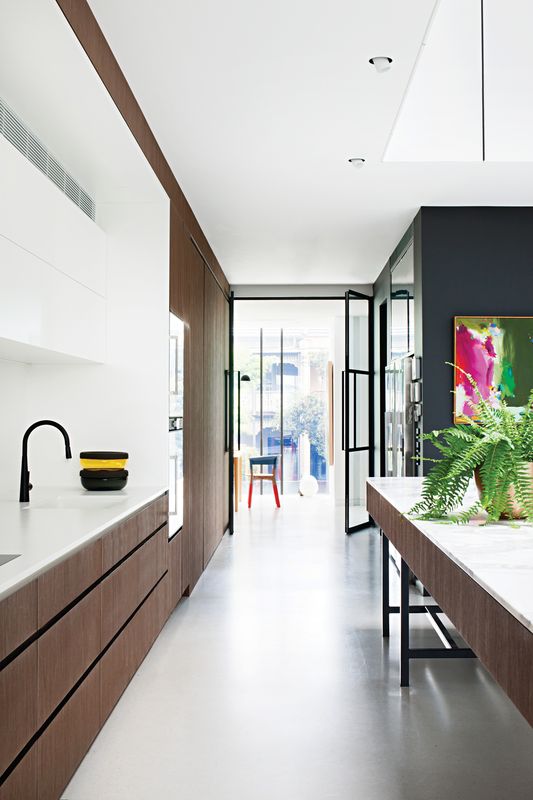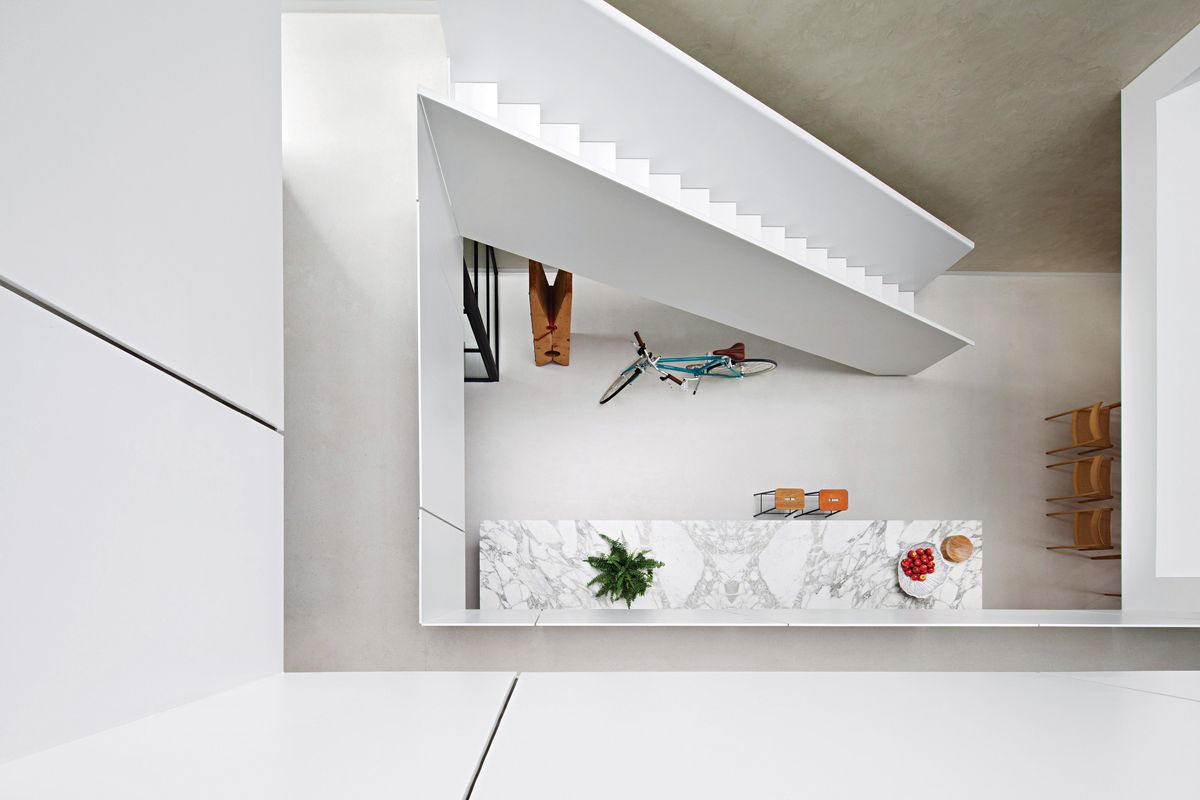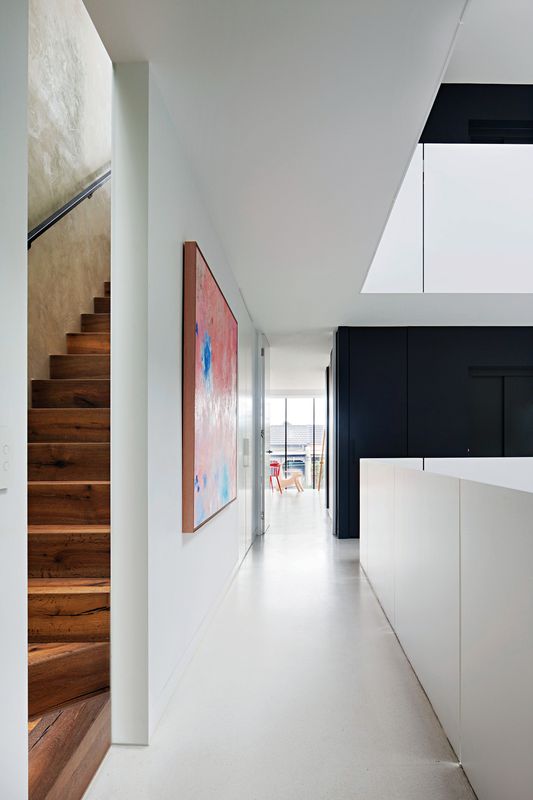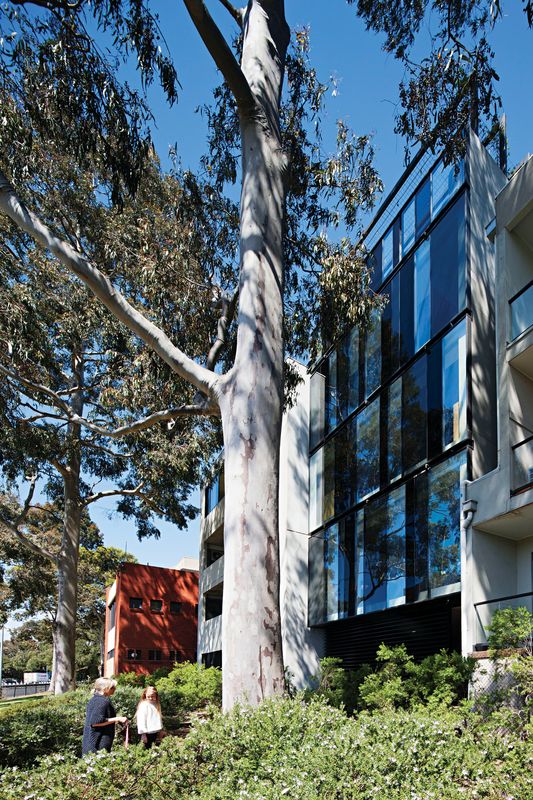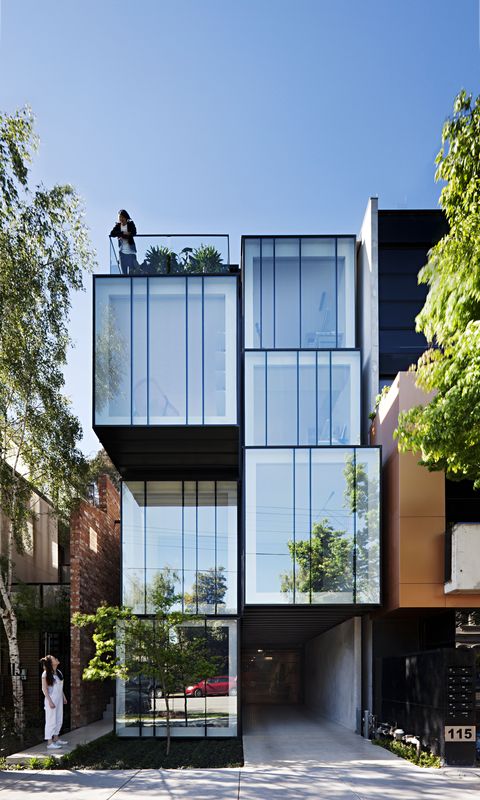There is an alluring boldness to the street facade of Mixed Use House. Designed by Matt Gibson Architecture and Design with DDB Design, it sits on a busy through-route for traffic between St Kilda’s Chapel and Fitzroy Streets, within a diverse mix of housing stock and commercial tenancies. The building responds as much to this street ambiguity as to its site constraints. On a 6.8-metre-wide, 190-square-metre parcel of land previously occupied by a two-storey brick garage, the new Moshe Safdie-esque composition of stacked volumes protrudes and retracts over five levels, taking on a compartmentalized language and creating intrigue as to the program within.
Mixed Use House by Matt Gibson Architecture and Design and DDB Design.
Image: Shannon McGrath
Located in a commercially zoned precinct, the site was purchased by a couple (a builder/developer and interior designer respectively) with two adult children and a young daughter. They saw the site as both a prospect for potential development and an opportunity for the family to live closer to the city, work, schools and universities. While zoning discouraged developing for residential use, council was willing to support a residential proposal based on its ability to be woven into the existing street fabric. Responding to this condition, the architect undertook a series of design studies, which drew reference from the existing street context to inform the breaking up of the mass and the division of the five levels.
While the narrow site determined the vertical response and the character of the street suggested the massing and storey heights, the clients’ objective to explore and rethink traditional family housing typologies with the architect became key to the ensuing form and spatial planning. Their brief was for “an adaptable and connected vertical home that provided a more sustainable lifestyle, [allowing the family to be] less reliant on cars, closer to the city and their workplace, and the opportunity to do something unique on an under-utilized infill site.” The house also needed to accommodate live-in extended family (including partners and grandparents), while ultimately exploring alternative models of living and working. From its inception the building was to house seven to nine people and, as is the case in most multi-generational houses, the balance between communal and private spaces was crucial.
Multi-generational living is becoming increasingly popular across Australia as families try to cope with housing unaffordability and the effects of population growth on the amount of available housing. For the clients of Mixed Use House, director Matt Gibson reflects, “There was a very positive [aspect to this model], which was about location, amenity and spaces that could allow flexibility with both connection and retreat.”
The architect divided the house into three zones: communal, personal and retreat. With council stipulating that the ground floor be dedicated to commercial use, one half of this level is occupied by a commercial tenancy, while to the right, vehicular access is carved out as a recess in the form. The discrepancy between the program at street level and the noticeably residential character of the boxes above often leads to public uncertainty about the nature of the building. It’s not until the first floor that the residential component is introduced, after which each box appears to take on an individual personality.
The atrium also serves to knit the residential levels together and to act as an interstitial space between private zones.
Image: Shannon McGrath
The design was focused on maximizing the footprint density of the site and gaining as much access to natural light as possible. Above the kitchen, dining and entry space on the first floor, a large, centrally located atrium draws natural light deep into the middle of the building. On the upper levels, the bedrooms and private spaces are planned around this void, with access between rooms along the edge of the void. This interstitial space between private zones becomes communal when family members communicate with each other by speaking into the void. Natural light is also drawn into each level through full-height glazing on both the northern and southern elevations. Each elevation is distinct: the southern street entry elevation is a playful movement of zinc-clad boxes, while the northern elevation, facing a busy freeway, is veiled in a glazed curtain wall and looks more like a commercial frontage.
The bedrooms are located at both ends of the house, against the south- and north-facing facades, and occupy the full building width. Each bedroom features its own ensuite and breakout space and in many ways they feel like individual, self-contained studios. Ensuite services were stacked where possible, taking a multiresidential approach that hints at a possible future use.
The architects and clients built an inherent separability into the building that would allow future subdivision, should the family’s situation change over time.
Image: Shannon McGrath
Retreat space was carefully considered and separated from communal and private spaces, the architect understanding the desire for individuals to seek out privacy away from their bedroom or study. A roof terrace and lounge are located on the uppermost level, with access via an impressive timber-clad stair, tucked away against the eastern boundary wall. This acknowledgement of the need for retreat responds to the fact that open-plan living is not always popular in multi-generational housing.
Thinking about the future, the clients and architect discussed the ways in which the house might physically change to adapt to varying family conditions and options for when the live-in family radically shrinks. There is an inherent separability within the building that would allow the top levels to be disconnected from the lower levels by way of considered changes to the existing vertical access and lift programming, subdividing the house to create two separate tenancies. This intrinsic flexibility, combined with the site’s zoning, also provides the option for the building to shift further to a genuine mixed-use or commercial typology, a point of difference compared with other approaches to multi-generational housing.
In 2016 the precinct underwent rezoning and is now a true mixed-use zone, highlighting the success of this infill development as well as the role multi-generational housing plays in our future cities and the value of rethinking traditional housing typologies.
Credits
- Project
- Mixed Use House
- Architect
- Matt Gibson Architecture and Design
Collingwood, Australia
- Project Team
- Matt Gibson Architecture and Design project team Matt Gibson (principal), Martyn Weaver (architect), Phil Burns, Erica Tsuda (architectural assistants), DDB Design project team David McCallum (principal), Maryanne Quealy (designer)
- Architect
- DDB Design
Caulfield, Melbourne, Vic, Australia
- Consultants
-
Builder
DDB Design
Building surveyor Red Textas
ESD consultant Floyd Energy
Engineer Clive Steele Partners, Greer Consulting Engineers
- Site Details
-
Location
Melbourne,
Vic,
Australia
Site type Suburban
- Project Details
-
Status
Built
Completion date 2016
Category Commercial, Residential
Source
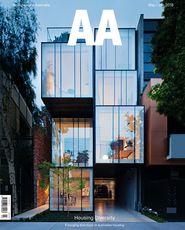
Project
Published online: 4 Jul 2018
Words:
Sarah Hurst
Images:
Shannon McGrath
Issue
Architecture Australia, May 2018

